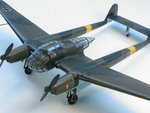kool kitty89
Senior Master Sergeant
Stich, the original specification behind the P-38 was for a small order of interceptors. As such the original P-38 design (ie that used for the XP-38 ) was not designed for large scale production. When this philosophy changed, significant changes had to be made to make it suitable for mass production. (the YP-38 and all subsequent aircraft)
Despite the inherant delay this would have caused in development, the crash of the XP-38 (which would still have been fairly representative for testing) delayed the whole program by over a year. (until the first YP-38 was ready)
And Marcel,
If you notice, pretty much all my posts are tied to the twin boom configuration's various advantages, layouts, and characteristics. (in fact I brought up the specific point you noted in my response to Bill -drgondog- in post #10)
Despite the inherant delay this would have caused in development, the crash of the XP-38 (which would still have been fairly representative for testing) delayed the whole program by over a year. (until the first YP-38 was ready)
And Marcel,
If you notice, pretty much all my posts are tied to the twin boom configuration's various advantages, layouts, and characteristics. (in fact I brought up the specific point you noted in my response to Bill -drgondog- in post #10)



